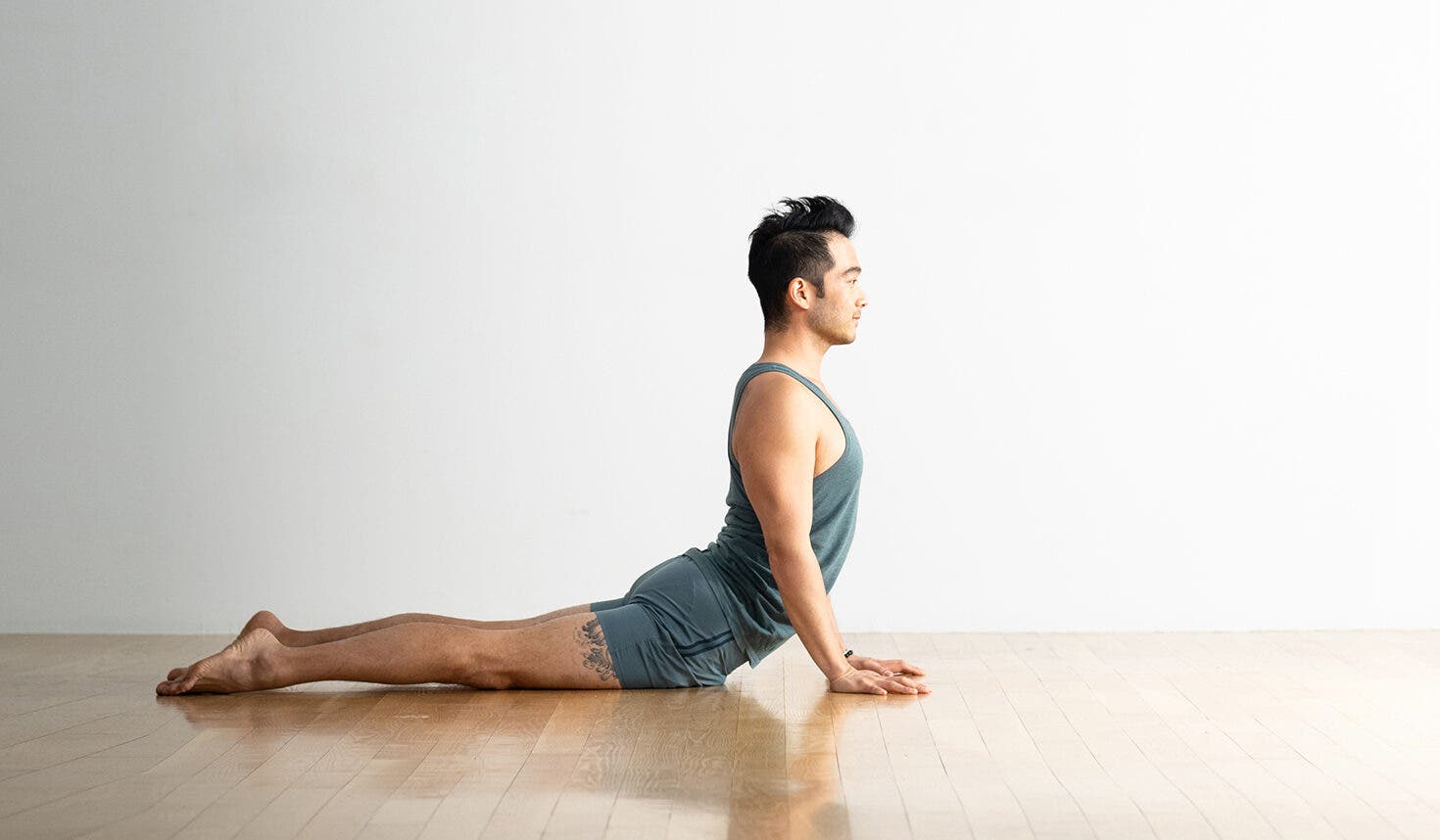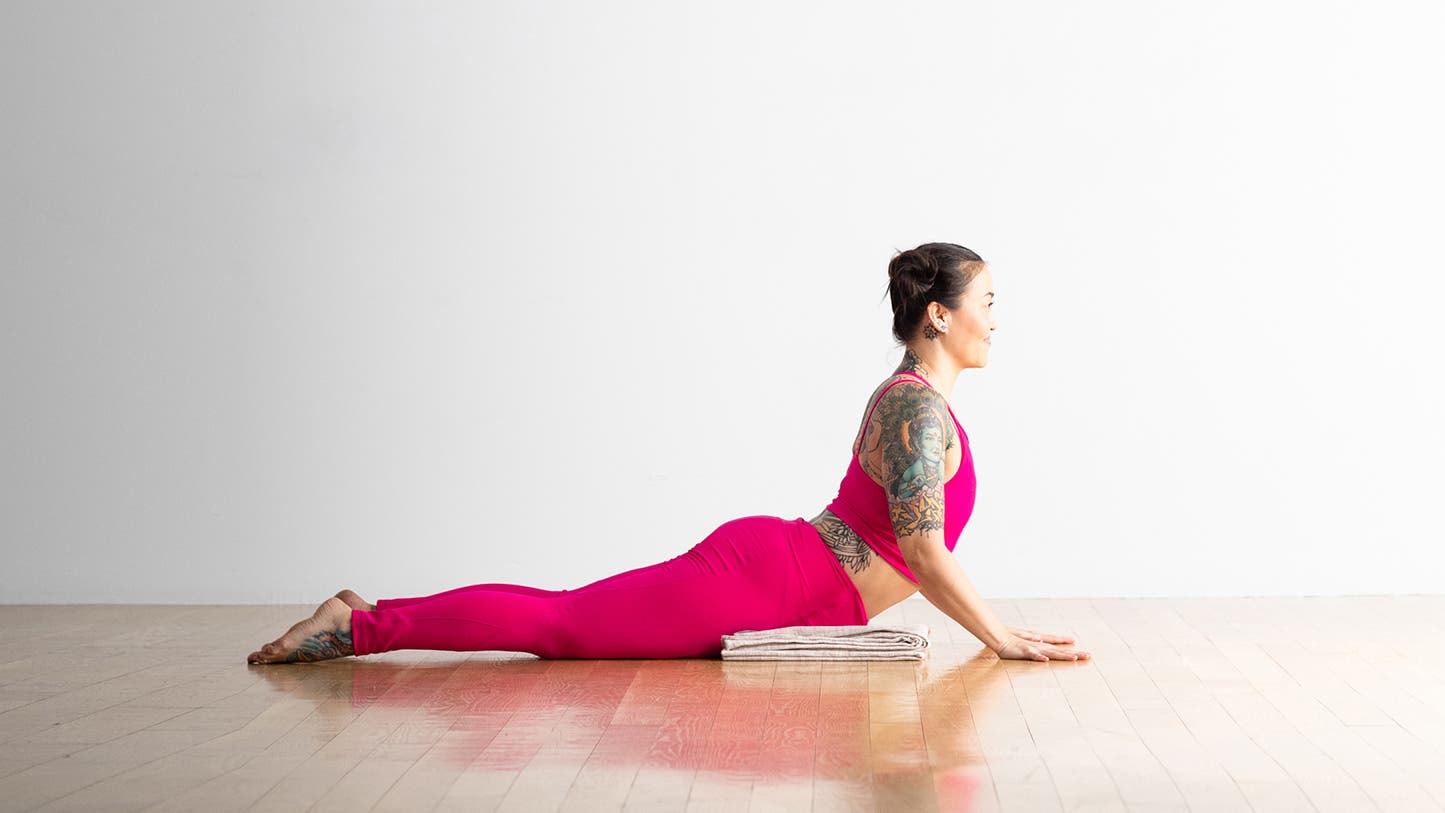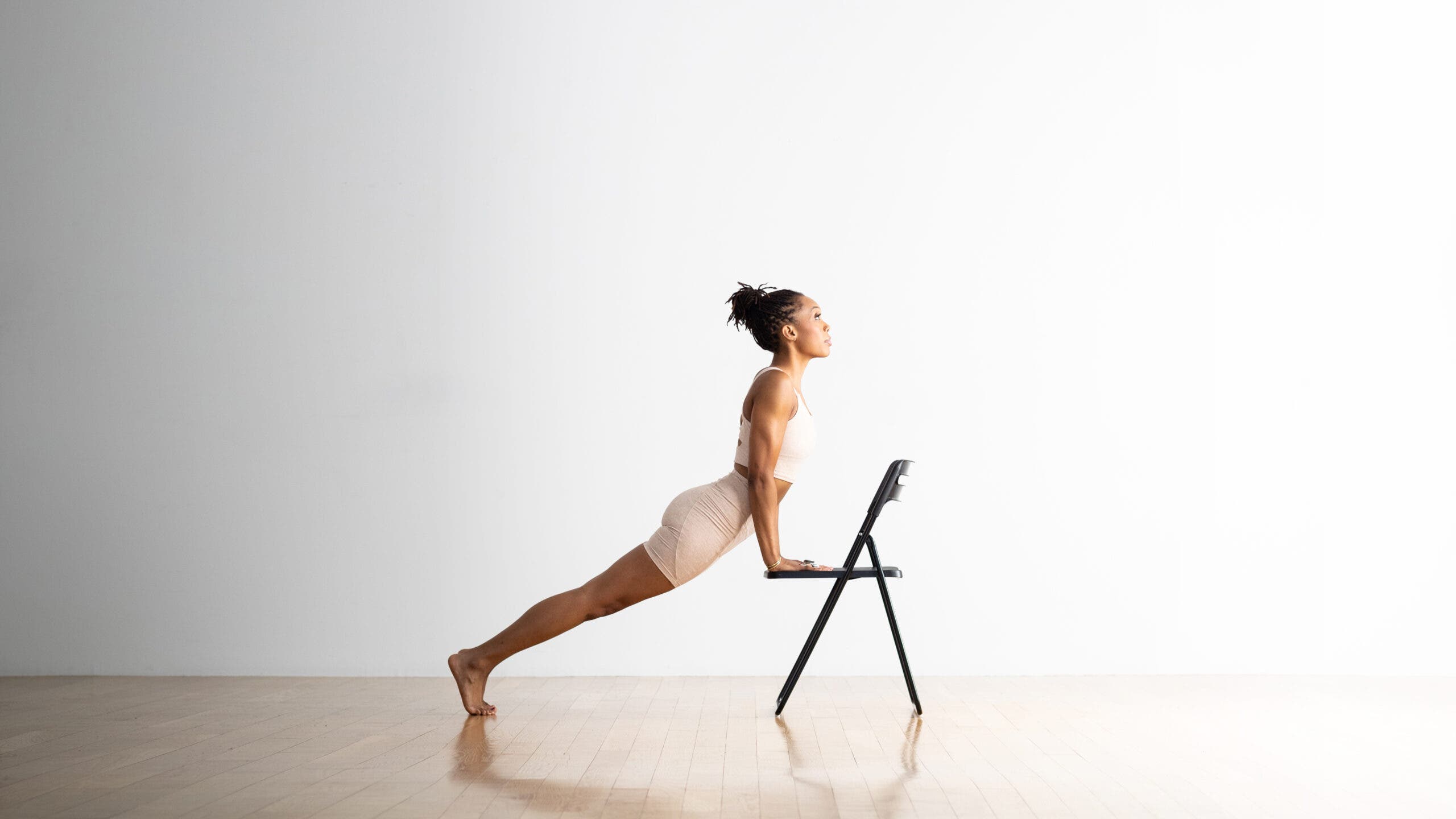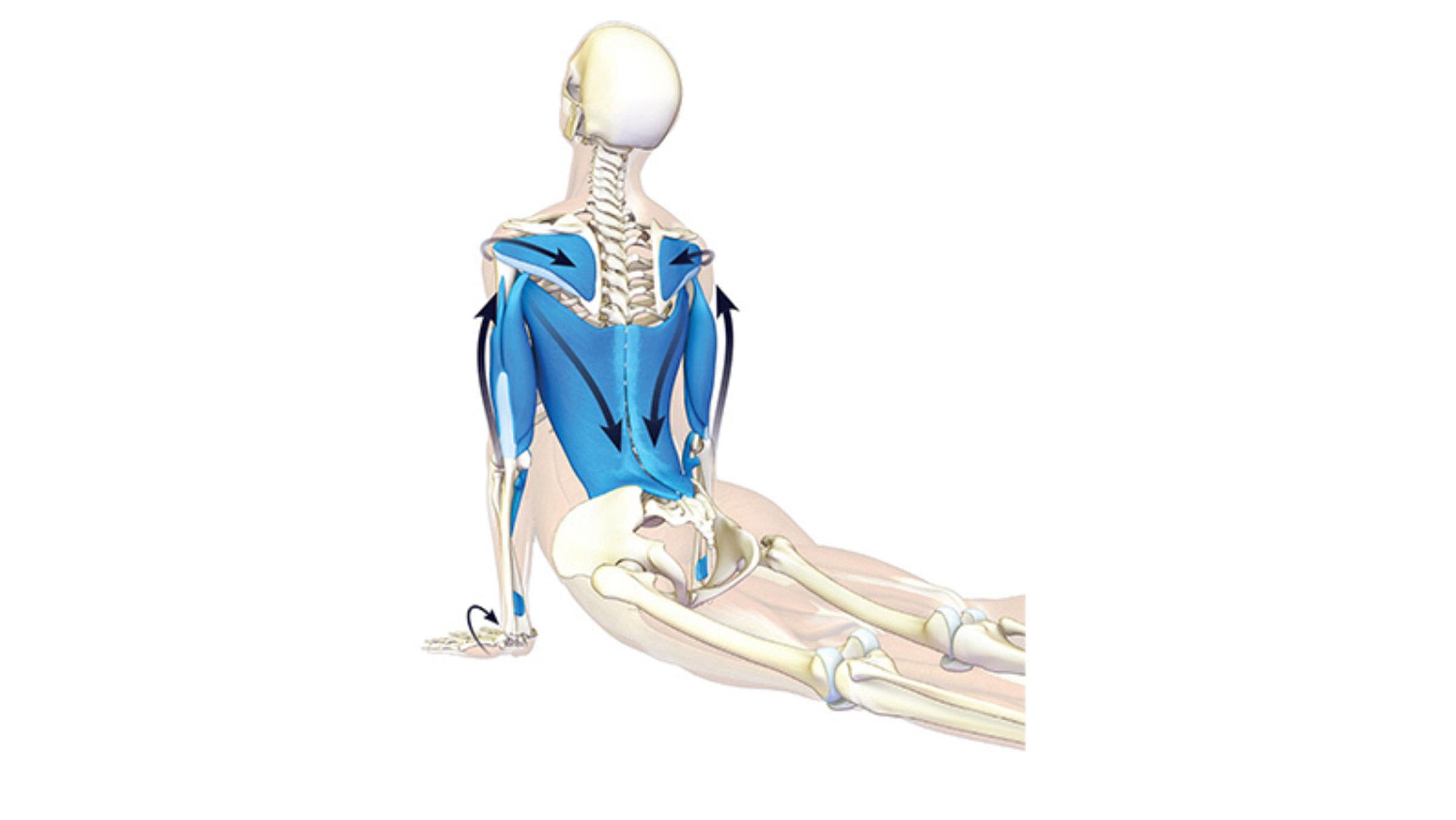If you buy through our links, we may earn an affiliate commission. This supports our mission to get more people active and outside.Learn about Outside Online's affiliate link policy
Upward-Facing Dog Pose

(Photo: Andrew Clark)
A classic yoga pose, Urdhva Mukha Svanasana (Upward-Facing Dog Pose) is an important part of the Surya Namaskar series. This powerful backbend opens your heart and lifts your head, while improving your posture—all physical movements that can combat feelings of depression and fatigue.
The pose requires you to put all of your weight on the palms of your hands and the tops of your feet; sinking down into your chest can put a strain on your lower back. Protect your wrists and lower back by aligning your wrists under your shoulders and pulling your shoulder blades back to open your chest. If your upper back is tight, your lower back may overcompensate, so it’s important to warm-up with poses like Baby Cobra Pose before Urdhva Mukha Svanasana.
Sanskrit
Urdhva Mukha Svanasana (OORD-vah MOO-kah shvon-AHS-anna)
ūrdhva = up
mukha = face
śvān = dog
How to
- Begin on your belly with your feet hip-distance apart and your hands placed beside your lower ribs.
- Extend your legs and press down with all ten toenails to activate your quadriceps.
- Rotate your inner thighs to the ceiling while firming your outer ankles into your midline.
- Press down with your hands and feet.
- On an inhalation, straighten your arms and lift your legs.
- With your arms perpendicular to the floor, your feet anchored, and your legs active, draw your chest forward and up.
- Draw your shoulders back while rooting down with your hands.
- Make sure that the curve of your neck is a continuation of the curve of your mid and upper back.
- Hold for 5 breaths, then release.
Upward-Facing Dog variations
Knees-down Upward-Facing Dog

If you find lifting your legs challenging, practice this pose with your knees and thighs on the ground.
Knees-down Upward-Facing Dog with blankets

To provide some cushioning for your body, place a folded blanket or two under your hip points.
Upward-Facing Dog Pose on a chair

Place a chair so that it is stable on a sticky mat and/or against a wall. Stand facing the chair and place your hands to the seat of the chair and press downward (not forward). Walk your feet back until you are in an inclined plank pose. Press your hips forward, arch your back, and look forward or slightly up to create a smooth curve along the length of your spine. Stay for several breaths, then walk your feet back in closer to the chair.
Upward-Facing Dog basics
Pose type: Backbend
Targets: Core
Benefits: Upward-Facing Dog is an energy-boosting posture that may help relieve lower back pain. It can also help counteract slouching and kyphosis (the abnormal curvature of the spine). It is a great posture to counteract the effects of prolonged sitting.
Other Upward-Facing Dog perks:
- Boosts energy and fights fatigue
- Builds confidence
- Strengthens your shoulders, arms, and back muscles
Beginner tip
As you press through the palms, draw your hips and chest slightly forward, toward the front of the mat. It brings expansion despite the strain of the pose.
Explore the pose
To increase the strength and lightness of this pose, push from the backs of your knees along the calves and out through the heels. The tops of your feet will press more firmly against the floor; as they do, lift the sternum up and forward.
Be mindful!
- There’s a tendency in this pose to “hang” on the shoulders, which lifts them up toward the ears and “turtles” the neck. Actively draw the shoulders away from the ears by lengthening down along the back armpits, pulling the shoulder blades toward the tailbone, and puffing the side ribs forward. If you need help learning this, lift each hand on a block.
Why we love this pose
“Up Dog is such an energizing pose,” says Tracy Middleton, Yoga Journal‘s former brand director. “I used to rely too heavily on my back muscles to achieve this posture, but then a teacher reminded me to focus on staying active through my legs—pressing down with the tops of my feet and really lifting my thighs. My back was less arched but I gained more length in my spine.”
Teacher tips
These cues will help protect your students from injury and help them have the best experience of the pose:
- Make sure your shoulders don’t creep up toward your ears. This happens when you rest your weight in your wrists, instead of pressing through your hands. By pressing through your hands, you’ll create the length necessary for this pose.
- When you lift your legs, actively press the tops of your feet into the mat to lift the kneecaps and, most importantly, awaken and engage the quads.
Preparatory and counter poses
This is a relatively gentle backbend that can be done toward the beginning of class to warm up your spine. If this pose causes any pain or discomfort, modify with a gentle Bhujangasana (Cobra Pose) until you feel your back body is ready for a deeper heart opener.
Preparatory poses
Setu Bandha Sarvangasana (Bridge Pose)
Counter poses
Adho Mukha Svanasana (Downward-Facing Dog)
Anatomy
Urdhva Mukha Svanasana extends the back body to create a focused stretch in the front. Concentrate on individual regions, and notice how each region affects distant parts. For example, feel how straightening your elbows extends the back and puts more pressure on the tops of your feet. Roll your shoulders back and observe how it opens your chest and draws your pelvis forward. Flex your feet and notice the effect on the front of your pelvis.
In the drawings below, blue muscles are contracting. The shade of the color represents the force of the stretch and the force of contraction. Darker = stronger.

Contract your triceps to straighten your arms. Press the mounds at the base of your index fingers into the mat. Connect your hands and shoulders by externally rotating the humeri. These actions together create a helical line of force through the elbows, stabilizing the arms and shoulders.
Engage the rhomboids to draw your shoulder blades toward your midline and open the front of your chest.

Engage the erector spinae to extend the vertebral column. Activate the gluteus maximus and medius to extend the hips and femurs. The gluteux maximus will naturally turn the femurs outward. Counteract this tendency by pressing the tops of the feet into the mat. Attempt to draw the thighs together to activate the adductor magnus and synergize the gluteux maximus in extending the hips.
Excerpted with permission from The Key Poses of Yoga and Anatomy for Backbends and Twists by Ray Long.
Put Upward-Facing Dog into practice
A key component of any Surya Namaskar (Sun Salutation), here are a few flows to try to put Upward-Facing Dog into practice:
How to Flow Through the Heat of Pitta Season With Grace
12 Poses to Transform Your Backbends
About our contributors
Teacher and model Natasha Rizopoulos is a senior teacher at Down Under Yoga in Boston, where she offers classes and leads 200- and 300-hour teacher trainings. A dedicated Ashtanga practitioner for many years, she became equally as captivated by the precision of the Iyengar system. These two traditions inform her teaching and her dynamic, anatomy-based vinyasa system Align Your Flow. For more information, visit natasharizopoulos.com.
Ray Long is an orthopedic surgeon and the founder of Bandha Yoga, a popular series of yoga anatomy books, and the Daily Bandha, which provides tips and techniques for teaching and practicing safe alignment. Ray graduated from the University of Michigan Medical School and pursued post-graduate training at Cornell University, McGill University, the University of Montreal, and the Florida Orthopedic Institute. He has studied hatha yoga for over 20 years, training extensively with B.K.S. Iyengar and other leading yoga masters, and teaches anatomy workshops at yoga studios around the country.